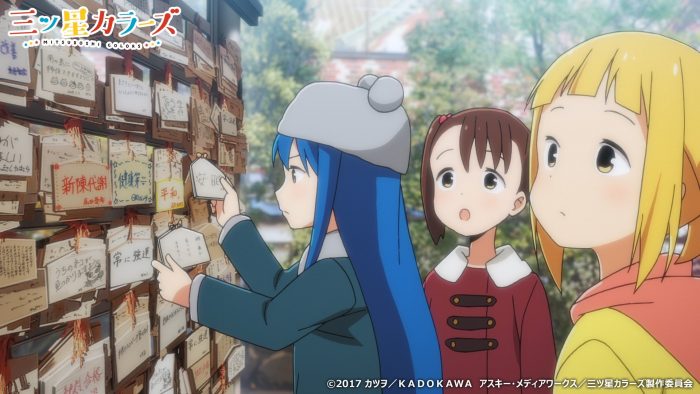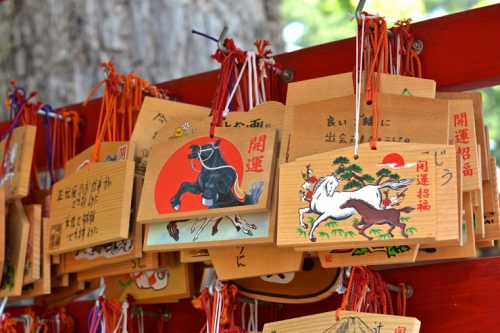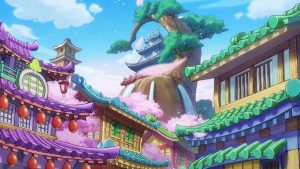
Japan is a very old country steeped in traditions that are uniquely, well, Japanese. Many parts of Japanese culture have been around for thousands of years, heavily affected by the amount of time that Japan was cut off from most of the world. At the same time, Japan has a rich and ever-changing modern culture - including its famous pop culture in the forms of anime and manga! Japan is always a bit of a paradox, blending old and new cultures to create a country that really stands out. But as in many countries, Japanese traditions are influenced and affected by its modern culture, and sometimes that changes them.
Today, we are going to have a brief look at the Japanese practise of ema, which are commonplace at shrines across Japan, and how they have been affected by none-other-than otaku culture!
Wait, What Are Ema?

Ema are wooden plaques that are available for purchase at Shinto and Buddhist shrines across Japan. These plaques are usually just plain at least on one side, though some may feature a little bit of decoration. Often, the other side bears Zodiac animals or symbols related to Shintoism or the shrine they are purchased from. Ema are plain because the point of them is for the purchaser to write on and design them themselves! Japanese people (and many tourists, too) write their prayers and wishes on ema and then hang them up on walls in the shrine. According to Shinto and Buddhist belief, the point of ema is to allow the priests of the shrine and the gods themselves to know the person’s wishes. When the gods walk amongst the ema in the shrine, they read the wishes and choose those that they wish to grant. They remain hanging in the shrine until they are burned during special rituals.
How Has the Otaku World Changed Ema?

Ema have been a part of traditional culture in Japan for thousands of years (they date at least back to the 1100s), but like many things, they have adapted to a modern world, too. While the majority of ema are still used in a traditional, usual way, some have been heavily influenced by none other than the otaku world! If you take the time to look at the walls of ema at most major shrines, you shouldn’t be surprised to find a few with anime characters drawn on them hidden amongst the more usual ones. Some people add them as decoration, and others because they feel that character will help them with whatever wish they are asking for on the ema.
Some shrines have been taken over by otaku ema! For example, if you head to Kanda Myojin shrine near Akihabara, Tokyo, you can find hundreds of ema dedicated to girls from the Love Live!! anime series. Why? Because the anime had scenes that took place at that very shrine! This connects the anime to real life in a tangible way, and fans of the show love visiting a real-life location featured in the anime. This phenomenon happens at most shrines that have anime appearances, with fans creating ema asking their favourite characters for help with their problems or just for good luck. They came to the shrine because of the anime, after all, so they want to leave something special behind.
Then there are shrines that were never in an anime but have the fortune of having a similar name as a famous character or show. The most recent example of this has been happening in Oita Prefecture at Hachiman Kamado Shrine. This shrine bears the same name as the main character Kamado Tanjirou from the hit series Demon Slayer: Kimetsu no Yaiba. While the anime and manga take place in Tokyo far away from this shrine, that hasn’t stopped fans from feeling it’s connected.
Hachiman Kamado shrine has a historical legend attached to it about a demon that was defeated by the sun - and the demons in Demon Slayer are also prone to sunlight! Plus there’s a dragon on the ceiling of the shrine that looks like the one that appears when Tanjirou does his special attacks. Today, hundreds of ema decorate Hachiman Kamado shrine covered in art from Demon Slayer and fans of the show have brought a ton of money to this shrine that may have never made the map before. That’s why we said its name was fortunate!
Final Thoughts
Anime and manga have changed the face of a lot of things in Japan, including very old things like ema. While some might argue that anime characters all over a Shinto shrine isn’t right and feel this is negative, just as many people (if not more) will argue the opposite. Religious belief and shrine visitation is low in Japan now, especially amongst the younger generations. But the otaku world is doing its part to keep it alive. After all, otaku money is just as good as religious money - and the otaku are certainly buying a lot of ema and helping out the shrines! Ema are a great example of how otaku culture is changing traditional Japanese culture, and also how it’s keeping it alive, too!
How do you feel about anime ema at shrines? Would you like to buy or draw one? What characters would you put and why? Do you think that otaku culture has had a positive effect on ema? Let us know in the comments!



